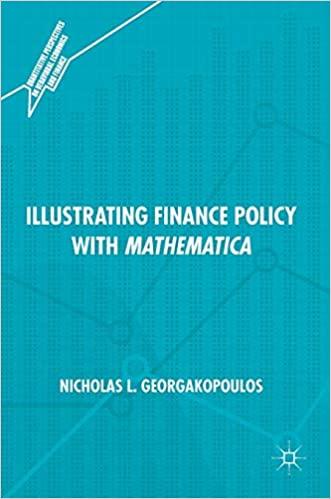Question
1. Empirical evidence suggests that historically, short-term T-notes trade at higher yields relative to long-term T-notes or T-bonds most of the time. True or False?
1. Empirical evidence suggests that historically, short-term T-notes trade at higher yields relative to long-term T-notes or T-bonds most of the time. True or False?
2. Empirical evidence shows that forward rates are
| A. | upward-biased predictors of future spot rates |
B. downward biased predictors of future spot rates
C. unbiased predictors of future spot rates
3. The yield curve flattening is historically a warning sign of an upcoming recession. True or False?
4. Which of the following is not credit or credit-related risk?
A. Risk of market interest fluctuation
B. Downgrade risk
C. Default risk
D. Credit spread risk
5. Which of the following is not a major credit rating agency?
A. Moody's
B. Standard & Poor
C. Fitch
D. Bloomberg
6. After issuance, bond ratings cannot be updated. True or False?
7. What of the following is not investment-grade on S&P's rating scale?
A. BBB-
B. AA-
C. BB+
D. BBB
8. Once a bond defaults, bond holders lose all of their holding's value. True or False?
9. Bonds of which one of the following ratings typically trade at the highest credit spread? Ratings are on S&P's schedule.
A. BB-
B. BBB-
C. BB
D. B
10. According to Moody's, particular bond issue for firm A has a default rate of 5%, and an expected recovery rate of 40%. What is the expected default loss rate of this issue?
11. Company X operates in a highly competitive industry, in which no company has a significant market share, and where there are low barriers to entry. Which of the following best describes company X's ability to take on substantial debt?
A. Its ability is high because companies in industries with those characteristics typically have high operating margins and cash flows that can support significant debt levels.
B. Need more info
C. Its ability is limited because companies in industries with those characteristics generally cannot support high debt levels.
12.Which of the following would not be a bond covenant?
A. The company must file financial statements with the bond trustee on a regular and timely basis.
B. All the others would be typical bond covenants.
C. The company's debt-to earnings ratio may not exceed a certain threshold
D. The company can issue new debt as much as the management likes
13. Which of the following statements about recovery rate is false?
A. Recovery rates for bonds of the same credit ratings are the same.
B. Recovery rates vary by industry.
C. Recovery rates vary throughout a credit / economic cycle.
14. Which one of the following two credit risk measures would you expect to lead changes in the other?
A. The two are typically updated on the same frequency basis
B. Credit ratings lead changes in expected default frequency
C. Expected default frequency leads credit ratings
16. Company A has an expected default frequency of 3%. Company B has an expected default frequency of 15%. Which of the following statements is true?
A. Company B is 5 times more likely to default relative to company A.
B. Company A is 5 times more likely to default relative to company B.
C.Company B is 12 times more likely to default relative to company A
D. The two companies are equally likely to default.
|
|
Step by Step Solution
There are 3 Steps involved in it
Step: 1

Get Instant Access to Expert-Tailored Solutions
See step-by-step solutions with expert insights and AI powered tools for academic success
Step: 2

Step: 3

Ace Your Homework with AI
Get the answers you need in no time with our AI-driven, step-by-step assistance
Get Started


